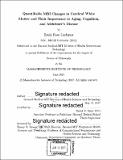| dc.contributor.advisor | David H. Salat. | en_US |
| dc.contributor.author | Lindemer, Emily Rose | en_US |
| dc.contributor.other | Harvard--MIT Program in Health Sciences and Technology. | en_US |
| dc.date.accessioned | 2017-09-15T15:29:34Z | |
| dc.date.available | 2017-09-15T15:29:34Z | |
| dc.date.copyright | 2017 | en_US |
| dc.date.issued | 2017 | en_US |
| dc.identifier.uri | http://hdl.handle.net/1721.1/111333 | |
| dc.description | Thesis: Ph. D., Harvard-MIT Program in Health Sciences and Technology, 2017. | en_US |
| dc.description | Cataloged from PDF version of thesis. | en_US |
| dc.description | Includes bibliographical references (pages 145-162). | en_US |
| dc.description.abstract | Alzheimer's disease (AD) is a neurodegenerative disease for which there are no preventative or therapeutic interventions. It is currently understood to be linked to the accumulation of pathologic proteins in the brain. In the past several decades, a strong body of evidence has accumulated that is suggestive of a vascular-related pathway in AD. A deeper understanding of this phenomenon is critical in advancing our understanding of the AD biological process as well and may lead to the discovery of novel therapeutic targets. A common age-related change in the brain is the development of white matter signal abnormalities (WMSA) as seen on magnetic resonance imaging (MRI). These lesions are related to cognitive function and are thought to be due to compromised integrity of the brain's vascular system. Despite evidence that WMSA are known to influence the clinical progression of AD, we do not currently view AD as a vascular disease nor do we use WMSA as a clinical indicator of AD. This is because we still do not know whether or not WMSA are a distinct phenomenon in AD, their relationship to traditional AD biomarkers, and how they independently contribute to clinical status. In this work, we examine if and how WMSA are related to AD conversion, whether they differ in their spatial distribution between typical aging and AD, and how they are linked to classic pathologic markers of AD. This work also includes technical development for WMSA quantification and baseline studies of WMSA in cognitively healthy aging. The main findings of this work suggest that WMSA are distinctly different in AD than in typical aging and have a unique role in AD progression. This not only motivates the utility of WMSA in our clinical treatment of AD, but also provides insight into the biological underpinnings of the disease process that may lead to novel therapeutic targets. | en_US |
| dc.description.statementofresponsibility | by Emily Rose Lindemer. | en_US |
| dc.format.extent | 162 pages | en_US |
| dc.language.iso | eng | en_US |
| dc.publisher | Massachusetts Institute of Technology | en_US |
| dc.rights | MIT theses are protected by copyright. They may be viewed, downloaded, or printed from this source but further reproduction or distribution in any format is prohibited without written permission. | en_US |
| dc.rights.uri | http://dspace.mit.edu/handle/1721.1/7582 | en_US |
| dc.subject | Harvard--MIT Program in Health Sciences and Technology. | en_US |
| dc.title | Quantifiable MRI changes in cerebral white matter and their importance to aging, cognition, and Alzheimer's disease | en_US |
| dc.title.alternative | Quantifiable magnetic resonance imaging changes in cerebral white matter and their importance to aging, cognition, and AD | en_US |
| dc.type | Thesis | en_US |
| dc.description.degree | Ph. D. | en_US |
| dc.contributor.department | Harvard University--MIT Division of Health Sciences and Technology | |
| dc.identifier.oclc | 1003290773 | en_US |
